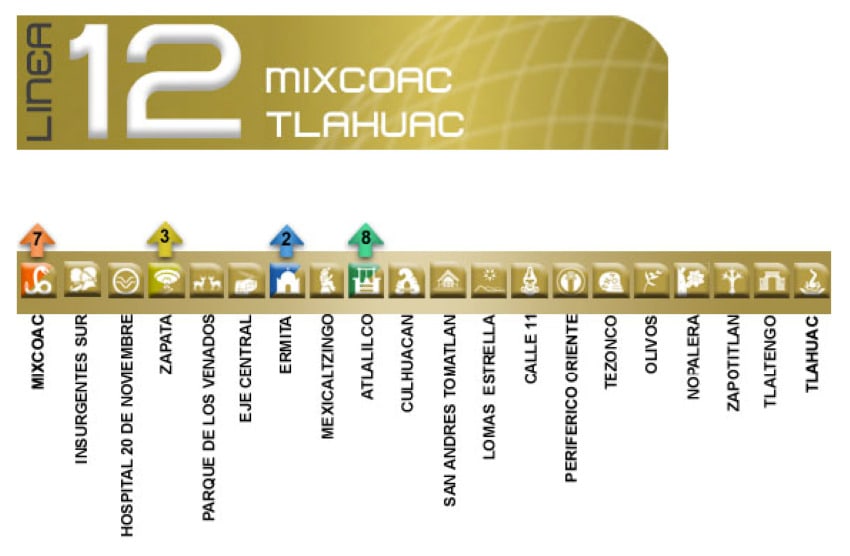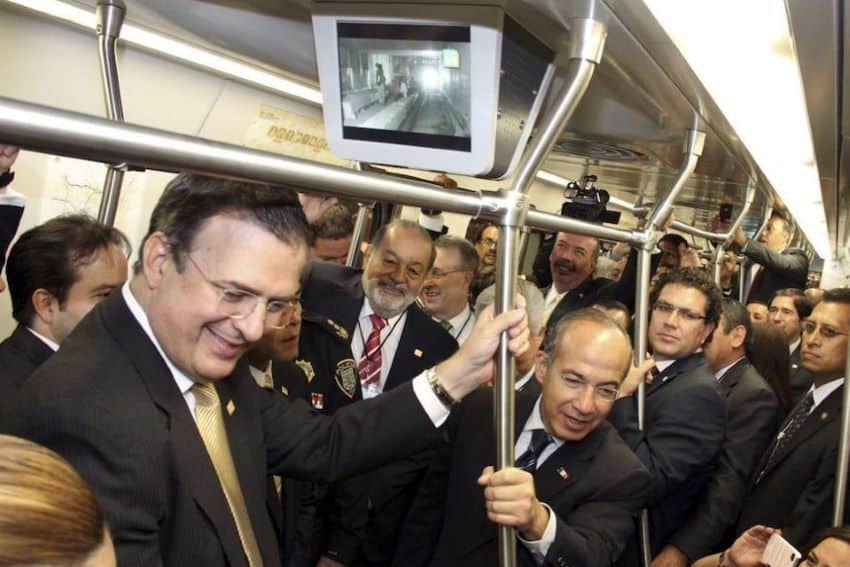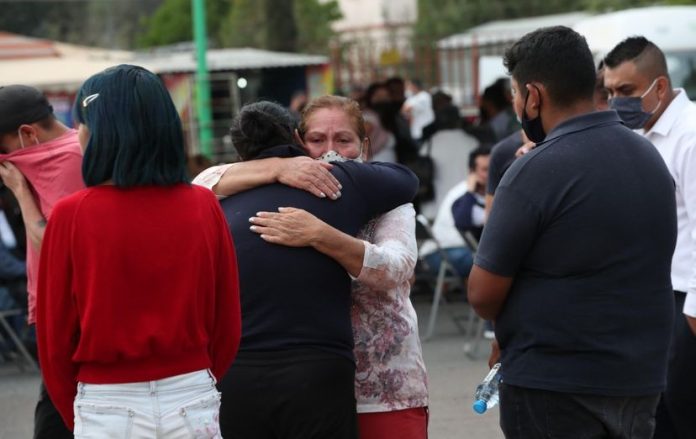The newest line of the Mexico City subway system, the scene of a shocking train crash on Monday night that claimed the lives of at least 25 people and injured about 80 others, has been plagued by problems since it opened in 2012.
An elevated section of the Metro’s Line 12, also known as the Golden Line, collapsed at 10.22 p.m. Monday, causing two train carriages to plunge onto a busy road in the capital’s southeast. Firefighters and other rescue workers labored for hours to free trapped passengers, more than 20 of whom died at the scene.
The death toll from the crash, the worst ever on the 52-year-old transportation system, rose to 25 late on Tuesday. The victims, 21 males and four females, range in age from 12 to 76.
Monday night’s tragedy was caused by the collapse of a girder on the elevated section of the Metro near the Olivos station, according to Mayor Claudia Sheinbaum. She told a news conference Tuesday that the collapse appeared to indicate a structural failure.
Sheinbaum also said that the entire Golden Line, built when Foreign Minister Marcelo Ebrard was mayor between 2006 and 2012, had been inspected last year with no major problems detected. She also said there is daily maintenance on the line.

Public Works Minister Jesús Antonio Esteva said that the structural collapse was not the result of a defect that had worsened over time. The Metro system and the government “never had information” about “growing damage,” he said.
A Norwegian company will conduct an independent investigation into the crash and the state of the entire line, which runs between Mixcoac in Mexico City’s southwest and Tláhuac in the southeast. The federal Attorney General’s Office and its Mexico City counterpart will also conduct probes into the incident.
“The promise that I am making to the Metro users, to the citizens, is to get to the bottom of this terrible incident,” Sheinbaum said.
The 26-billion-peso (about US $2 billion at the 2012 exchange rate) Golden Line, used by about 220,000 passengers per day, opened amid fanfare in late 2012 with officials touting that it would drastically reduce travel time for residents of outlying neighborhoods of the capital. But problems quickly emerged.
According to media reports, there were 60 mechanical failures on trains or tracks during the line’s first month of operation. Engineers warned of the potential for derailments, and trains were consequently required to reduce their speed on the elevated section of the line.
In an interview with the newspaper El Universal, Fernando Espino Arévalo, the head of the Metro workers union, said a range of problems, including vibrating support columns on elevated sections of the track, have been reported to authorities since 2012. However, the union’s concerns were ignored, he said.
In a radio interview, Espino apportioned blame for Monday’s disaster to the French company TCO, which he said was responsible for maintaining the line.
“We are constantly insisting that maintenance be our responsibility,” he told Imagen Radio. “But, unfortunately, the authorities don’t listen to us and don’t let us help. They get rid of the best technicians that we have because [the technicians] don’t agree with what the administration demands.”
In 2014, several of the Line 12 stations were closed for structural repairs, leaving about half the line — the elevated section — out of service for months. Government data shows that at least one support column was damaged in the powerful September 2017 earthquake that killed hundreds of people in Mexico City.
The column, located not far from where Monday’s crash occurred, was repaired. But people who live near the scene of the accident questioned the quality of the reconstruction, according to The New York Times.
Four residents told the news agency Reuters that they witnessed columns supporting elevated sections of the line shaking when trains passed over them.
“Every time I saw the train, I saw the columns and beams shake,” said Víctor Lara, who used Line 12 on a daily basis. “They’re not well-made.”

Some of the locals who spoke with Reuters recalled that there were warnings about soil in the area being unsuitable for major construction.
Built by a consortium of companies that included billionaire businessman Carlos Slim’s CCICSA, Mexican firm ICA and the Mexican division of France’s Alstom, the Golden Line — like many infrastructure projects in Mexico — has also been the subject of corruption allegations.
In 2018, federal senators with the Institutional Revolutionary Party (PRI) called on the Mexico City government to report to Congress about alleged irregularities in the funding to construct Line 12. The PRI lawmakers said in an official party document that the Golden Line was a “symbol of corruption and the misuse of public resources that prevailed during” Ebrard’s administration.
Jesús Urban, secretary-general of the Metro workers union, said Tuesday that structural damage at the point where Monday’s crash occurred was reported six months ago but authorities didn’t listen. He told the newspaper Milenio that work was subsequently carried out on the beam that collapsed but the maintenance done was not what was needed.
Urban said the Mexico City government, including the mayor’s office, was aware that maintenance was a problem. It spent 780 million pesos on Line 12 in the past five years and 1.1 billion pesos on repairs in 2014, according to the newspaper Reforma, but was ultimately unable to ensure its safety. In addition, the Metro system was without a director of infrastructure maintenance for a year before Mayor Sheinbaum filled the position last week.
Héctor Homero Zavala, another representative of the Metro union, said Monday’s tragedy could have been averted if the government had heeded the warnings it received.
“If us workers were really listened to by this administration, a lot of problems would be avoided,” he said.
“… The Mexico City government must understand that the entire [Metro] system is at risk at the moment, mainly Lines B, 5 and 9, where an even greater tragedy could occur,” Zavala said.
Many of the Golden Line problems, concentrated on its elevated section, could perhaps have been avoided if the entire line had been built underground, as was originally planned. In a 2015 report, a Mexico City Congress committee lamented the decision to make part of the line elevated rather than subterranean, an apparent cost-cutting measure.
“The modification of the basic engineering of the project resulted in a chain of problems,” the report said.
President López Obrador, who declared three days of national mourning for the victims of the disaster, said Tuesday the investigation into the crash should be completed quickly and that nothing should be hidden. He pledged at his regular news conference that there will be “no impunity for anyone.”
Ebrard said he will cooperate fully with the investigation and that he had nothing to hide or fear, although critics accused him of rushing to complete construction of the Golden Line while he remained mayor in order to add the project to his political legacy.

“Like anyone else, I am subject to whatever the authorities determine, but even more so as a high-level official, as someone who promoted the construction of the line,” he said.
The foreign minister’s office released a statement saying that Line 12 is the “most audited” infrastructure project in the history of the country. No reports on inspections of the line mentioned problems with beams or the structural integrity of the elevated section, the statement said.
The Metro system as a whole has suffered several other accidents in recent times, including a fatal crash in March 2020 and a fire in the its downtown substation in January.
Metro director-general Florencia Serranía, appointed to the position in 2018, said Tuesday that she would not resign as a result of the latest — and deadliest — incident.
“I will continue working and cooperate however I can to determine the structural damage,” she said.
Mayor Sheinbaum expressed her support for the Metro chief and declared, “We are not covering for anyone — the question here is, who is responsible?”
Source: Milenio (sp), Reforma (sp), Reuters (en), El País (sp), El Universal (sp), The New York Times (en), Vice World News (en)
